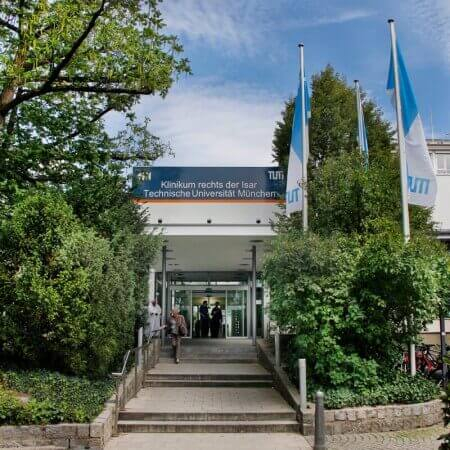Diagnostic of Uterine Fibroids (myoma Uteri)
Treatment prices are regulated by national law of the corresponding countries, but can also include additional hospital coefficients. In order to receive the individual cost calculation, please send us the request and medical records.

Department of Gynecology, Mammology and Obstetrics
The Department of Gynecology, Mammology and Obstetrics offers the full range of services in these fields, providing patients with the optimal treatment based on the very latest scientific advances and innovative technologies. The department's tasks include diagnostics and treatment of all gynecologic diseases and breast pathologies, as well as pregnancy management, childbirth and postnatal care for both mother and baby, elimination of fertility problems in women. The department has modern equipment for invasive and non-invasive diagnostics, three operating rooms equipped with state-of-the-art technology, especially in the field of minimally invasive and robot-assisted surgery, as well as special devices for microsurgery and fetal surgery. A competent medical team consisting of 18 senior physicians, 25 assistant physicians and medical specialists, obstetricians and specially trained nursing staff annually admits approximately 5,000 women for inpatient treatment and provides outpatient medical care for 14,000 patients. In addition, the department has four maternity rooms, in which about 2,000 babies are born annually.







Department of Adult and Pediatric Gynecology, Mammology, Obstetrics
According to the Focus magazine, the Department of Adult and Pediatric Gynecology, Mammology, Obstetrics is included in the ranking of the top German departments specializing in obstetrics and breast cancer treatment! The department offers the full range of diagnostics and treatment of diseases of the female reproductive system, breast pathologies. Also, the specialists of the department provide a comprehensive management of pregnancy, childbirth and postpartum care for both mother and child. Key attention is paid to the treatment of female genital cancers, as well as breast cancer treatment. For this purpose, the department has all the modern therapeutic techniques, as well as its our own innovative developments by the department doctors.







Department of Adult and Pediatric Gynecology, Mammology, Obstetrics
The Department of Adult and Pediatric Gynecology, Mammology, Obstetrics offers high-precision diagnostics and effective treatment of the full range of diseases of the female reproductive system and breast pathologies. The medical facility also employs a competent team of obstetricians, whose responsibilities include comprehensive management of pregnancy, childbirth, and postnatal care for mother and baby. More than 3,000 babies are born in the department's delivery rooms annually. The department cooperates closely with the UniFee Reproductive Medicine Center, which allows gynecologists to treat female infertility together with reproductive medicine specialists. The department's gynecologists focus on women with reproductive system cancers. The medical facility is certified by the German Cancer Society (DKG) as a specialized center. The specialists also successfully treat endometriosis, one of the most common benign gynecologic diseases. In the field of mammology, priority is given to the provision of medical care to women with breast cancer. Doctors perform comprehensive diagnostics, surgical and conservative treatment, and reconstructive plastic surgery after mastectomy. The department's specialists use state-of-the-art technical resources and their professional skills to provide each patient with high-quality medical service.






Uterine fibroids are a proliferate of fibrous tissue. It consists of altered myometrial cells (uterine muscle layer). This is one of the most common gynecological diseases in the world. According to autopsy, myoma is detected in 80% of all women. Nonetheless, in most of them a neoplasm does not cause any symptoms and does not affect fertility. Only when the neoplasm reaches large sizes, the women develops problems, which require medical care.
Diagnostic goals
It is not difficult to determine the fact of the presence of fibroids in the uterus. In this case, each patient with signs of this disease requires a thorough examination. It is necessary for:
- determination of the exact location of uterine fibroids, the size of the myomatous node and uterus;
- differential diagnostics (fibroids need to be distinguished from uterine malignancies, cysts and solid formations of the ovaries);
- assessment of the patient’s hormonal profile, selection of the hormonal treatment regimen for uterine fibroids (all these neoplasms are hormone-dependent);
- assessment of the peculiarities of the blood supply to the myomatous node (when planning treatment of uterine fibroids by uterine artery embolization or their surgical removal).
Clinical picture
Myoma can be detected by chance during an ultrasound scan. In other cases, patients go to the hospital for the targeted diagnostics of the disease in case of symptoms manifestation. These may be:
- vaginal bleeding;
- prolonged and heavy menstrual bleeding;
- chronic pelvic pain;
- frequent urination in case of bladder compression;
- constipation in case of rectal compression.
Some patients seek medical help because of infertility or miscarriage. The repeated uterine bleeding often leads to iron deficiency anemia. Sometimes a woman may be admitted to the hospital with a torsion of the node legs and a clinical picture of an acute abdomen. In this case, the main symptom is acute pelvic pain.
Imaging methods
The myomatous node can be detected using ultrasound. The method also helps to assess the location of the uterine fibroids. It can be located completely or partially:
- in the abdominal cavity;
- in the uterine cavity;
- intramuscularly (in myometrium).
Myomas can be single or multiple. They vary significantly in size. The small fibroids are more often found in young women. They may not have any clinical significance and are not an indication for treatment. At the same time, there may be diagnosed fibrous tissue myomatous nodes that pose a threat to health. They can lead to infertility, habitual miscarriage. They can also be complicated by torsion of the legs of the myomatous node and severe bleeding.
The ultrasound is performed using a transvaginal probe. A doctor can obtain more complete information about the disease using hydrosonography. The method involves contrasting of the uterine cavity with liquid agents. This type of ultrasound determines the type of myoma, its structure, exact localization, position to the internal os. The doctors assess the uterine angles, myometrial thickness, detect concomitant endometrial diseases.
Dopplerography is a type of ultrasound diagnostic method, which serves to evaluate the blood supply to the myomatous node. The method has gained great importance in the diagnostics of the disease after the introduction of the uterine artery embolization procedure into clinical practice. The benign myomatous nodes are supplied with radial arteries that form the perifibroid plexus. Dopplerography allows you to assess the blood flow velocity in the vessels. It is used for:
- assessment of the possibilities for uterine artery embolization to treat uterine fibroids;
- treatment planning;
- assessment of its results in dynamics (the results after embolization develop gradually, so dopplerography will be performed repeatedly).
Doppler ultrasound is also used to distinguish fibroids from sarcoma, which is a malignant tumor that can grow from the muscle layer of the uterus. In case of suspected sarcoma, the final diagnosis will be made via biopsy. Dopplerography allows to determine the indications for it.
Angiography was introduced into clinical practice in the treatment of uterine fibroids after the start of the use of endovascular (intravascular) surgery. Conventionally, it involves an X-ray examination of the uterine vessels after the introduction of a contrast medium into them. It is an obligatory test when preparing for uterine artery embolization. In Germany, MR angiography is often used. Magnetic resonance imaging is used instead of x-ray. This examination is safer.
Like dopplerometry, angiography can distinguish fibroids from sarcoma. The signs of sarcoma are:
- dichotomous type of blood supply;
- vast areas of disordered arrangement of blood vessels;
- small focal accumulations of blood;
- formation of vascular "lakes" in necrotic tissue (a sign appears with a rapidly growing tumor).
MRI is increasingly used in the best hospitals in the world. The method is most informative when using a contrast agent. It helps not only to assess the features of blood supply, but also is an indispensable method for the diagnostics of giant myomatous nodes. MRI allows for the accurate assessment of their topographic location.
Other examinations
Ultrasound or MRI are indispensable diagnostic methods for imaging the myomatous node located mainly in the myometrium. In addition, these methods allow for the assessment of the features of blood supply.
Since many fibroids are located mainly in the uterine or abdominal cavity, the patient also often needs additional examinations to clarify the diagnosis.
Hysteroscopy is an imaging examination of the uterine cavity using a hysteroscope. A flexible tube with a camera is inserted into the uterus. This is the gold standard for the diagnostics of submucous myomatous nodes. Hysteroscopy allows determining type of the node and evaluating its size. It also serves for the assessment of the possibility of performing surgical treatment, namely transcervical myomectomy.
Diagnostic laparoscopy is a minimally invasive surgical procedure, in which a tube with a camera is inserted into the abdominal cavity through a minimal incision on the anterior abdominal wall. It is performed to diagnose subserous myomatous nodes. The procedure allows to distinguish uterine fibroids from cysts, solid ovarian neoplasms and retroperitoneal tumors.
Diagnostics abroad with Booking Health
We can arrange your diagnostics in Germany or other developed countries. You have several reasons to book a fibroid diagnostic program in the best hospitals in the world using Booking Health service:
- We will select the best hospital that specializes in the diagnostics and treatment of this disease.
- The cost of medical services will be lower. You will save up to 50% due to the lack of overpricing and coefficients for foreign patients.
- Booking an appointment with a doctor on dates convenient for you.
- Preparation of a diagnostic program taking into account previous examinations.
- Provision of communication with an attending physician.
- Monitoring of all stages of the program.
- Monitoring of expenses and return of unspent funds.
- Communication with the hospital after treatment.
- Arrangement of additional diagnostics or treatment.
- Buying and forwarding of medicines.
Booking Health will provide you with the highest level of service. We will book airline tickets, the nearest hotel to the medical facility, we will meet you at the airport and deliver to the hospital. We will also provide an interpreter for you.

